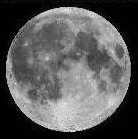Luna
This article is a Selenological stub. You can help Lunarpedia by expanding it.
|

In general terms, a moon is any natural satellite of a planet. The Moon usually refers to the Earth's primary natural satellite, sometimes called Luna. In a context in which one might refer to the moons of more than one planet, Luna is more specific than the Moon. The moon is of interest to space colonization advocates primarily because of the shallowness of its gravity well, its lack of atmosphere, the comparatively easy access to its natural resources, and its close proximity to Earth.
The Moon is the only celestial body on which humans have made a manned landing. While the Soviet Union's Luna programme was the first to reach the Moon with unmanned spacecraft in 1959, the United States' NASA Apollo program achieved the only manned missions to date, beginning with the first manned lunar orbiting mission by Apollo 8 in 1968, and six manned lunar landings between 1969 and 1972—the first being Apollo 11 in 1969. These missions returned over 380 kg of lunar rocks, which have been used to develop a detailed geological understanding of the Moon's origins (it is thought to have formed some 4.5 billion years ago in a giant impact event involving Earth), the formation of its internal structure, and its subsequent history.
Contents
Physical Properties
The moon has an orbital radius of about 384,000 kilometers, and an orbital period of approximately 28 days. The moon is in a state of tidal lock, meaning that its rotation period is exactly the same as its orbital period, with the result that one hemisphere of the moon always faces Earth. This allows continuous real time communication between Earth and a stationary antenna on much of the near side of Luna. The round trip communications delay always less than three seconds. On most parts of the moon, the lunar day is 14 Earth days long and lunar night is similarly 14 Earth days long. Since the moon is essentially airless, daytime and nighttime temperatures can be quite extreme, with daytime temperatures higher than 400 degrees Kelvin (250 degrees Fahrenheit) and nighttime temperatures lower than 100 degrees Kelvin (-250 degrees Fahrenheit). The axial tilt of Luna's rotation is one and a half degrees to the ecliptic. This allows solar electric generating stations to potentially be connected in a grid within 46 kilometers of either pole so that one or more stations is always in sunlight, except during eclipses of the Moon by Earth. Some Polar high spots are high enough or nearly so to be constantly in the sunlight.[1]
Natural History
The moon formed approximately 4 billion years ago. The generally accepted theory of lunar formation, proposed by William K Hartmann and Donald R Davis, is that the moon was formed as a result of a large impact between the Earth and a Mars-sized object. The resultant ejecta formed an orbiting ring of debris around the Earth which eventually coalesced into the now familiar moon.
Atmosphere of Celestial Bodies
Robotic Exploration
United States
Soviet Union
Lunokhod - Lunokhod meaning "Moonwalker"
Zond - Zond meaning "Probe"
Europe
China
India
Japan
SELENE (nicknamed called Kaguya)
Pending Missions
| Mission | Nation | Organization |
| LRO | United States | NASA |
| Red Rover | United States | Astrobotic Technologies |
| MoonOne | Isle of Man | Odyssey Moon |
Manned Exploration
United States
Reference
- 1. Peak of Eternal Light article at Wikipedia






